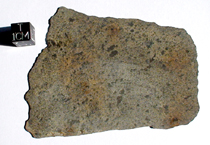Shergottites
The shergottites are named for their type specimen, an achondrite that fell
in Shergotty, India, in 1865. Comprising 17 distinct members, they represent
the most abundant type of Martian meteorite. Shergottites are igneous rocks of
volcanic or plutonic origin, and they resemble terrestrial rocks more closely
than do any other achondrite group. They all show exceptionally young
crystallization ages of about 150 to 200 million years, and they usually
exhibit signs of severe shock-metamorphism. Typically, the plagioclase in
shergottites has been converted to maskelynite, a glass that is produced when
plagioclase is subjected to shock pressures of at least 30 GPa. It is likely
that the maskelynite was formed by the impact forces that blasted the
shergottites from the Martian surface and into space. Calculations show that
it requires a major impact event to accelerate any material to a speed high
enough to escape the planet's gravity - one of the reasons why the SNC
meteorites are such a rare class. Based upon their mineral compositions, the
shergottites are further subdivided into two distinct subgroups: the basaltic
subgroup, and the lherzolitic subgroup.
|
Dhofar 019
Found Jan. 24, 2000, Oman
TKW 1,056 g
Transitional shergottite
Similarities with ALH 84001 !!!

|
|
|
|
Dhofar019 -00
perfect full slice, less than a mm thick !!! contains orangettes
like ALH84001
15.32gr
Price
on request
|
|
|
|
|
|
|
|
|
|
|
|
|
|
|
|
|
|
|
|
|
|
|
|
|
|
|
|
|
|
|
|
|
|
|
|
|
|
|
|
|
|